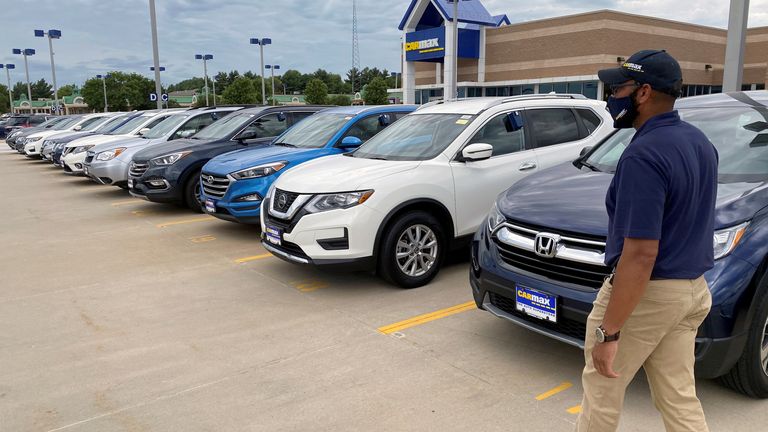US inflation revved up further last month partly thanks to the biggest monthly bounce in used vehicle prices for more than 60 years.
America’s consumer price index (CPI) rose by 5.4% in June compared to a year ago, matching a level last seen in 2008, as the economy continued to rebound from the coronavirus crisis and some supply chains struggled to keep up.
Inflation in the world’s biggest economy had already climbed to 5% in May and the unexpectedly strong latest reading adds to the potential headache facing the US Federal Reserve, which targets a 2% rate.
Image: Jerome Powell is due to give evidence to US legislators this weekThe latest figures showed the index for used cars and trucks rose by 10.5% between May and June alone, the biggest increase since it was first published in 1953.
That meant second hand cars were on average changing hands last month for 45% more than a year earlier.
AdvertisementThe CPI figures pushed the US dollar higher and gave pause to Wall Street shares – with the Dow Jones slipping from record highs despite hopes that the start of earnings season this week will deliver a bumper crop of quarterly profits.
Markets are gripped by the possibility that the Fed might have to hike ultra-low interest rates sooner than expected, a prospect that could both cool domestic growth and sow anxiety among global borrowers.
More from Business Encouraging start for an expected bumper earnings season on Wall Street COVID-19: Train and bus operators will no longer enforce mask wearing in England from 19 July One in five hospitality and retail workers self-isolating, MPs told Guy Hands eyes housebuilding empire with £700m Keepmoat bid Warning issued over financial sector’s reliance on cloud computing Bank of England removes bank dividend curbs as outlook improvesThe Fed, whose chair Jerome Powell is due to deliver two days of testimony to US legislators this week, has maintained that the rise in inflation is transitory – a temporary result of the bounce-back from last year’s recession.
Latest figures published by the Bureau of Labour Statistics showed that a fuel price rises – after oil slumped earlier during the pandemic – were a big part of the continuing uptick on inflation.
Image: The figures reflect the reopening of the US economyBut they also showed that even stripping out volatile food and energy prices, inflation was at 4.5%, its highest level on this measure since 1991.
The unprecedented increase for used cars and trucks accounted for a big chunk of the headline inflation number and comes after a shortage of semiconductor chips squeezed the supply of new vehicles.
New car prices rose by 2% month-on-month – the biggest increase since 1981 – while hotels and restaurants also put up their rates.
The rise in inflation is attributed to shortages of raw materials such as semiconductors and lumber as well as surging demand from consumers who are increasingly travelling, shopping and eating out, combined with a lack of workers to serve them – pushing up wages.
However, officials in Washington think the price spikes will fade as supply bottlenecks ease and the economy settles back to normal.
In any case, the Fed is aiming for inflation to remain above its 2% target for some time to make up for being below that level for much of the past decade.
Inflation has also picked up in the UK, though to a lesser extent – also attributed to factors that officials believe will prove transitory.
